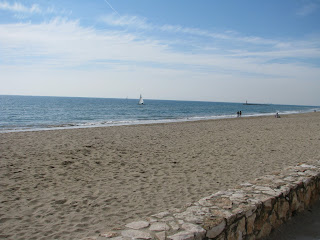It was 64 degrees Fahrenheit and sunny on Saturday (February 25!), the perfect day to take a one-hour train southward to the beach town of Altafulla for a traditional Catalan early spring feast: The Calçotada.
My friend, Jessica, booked a reservation for 15 of us at an organic farm in Altafulla where they grow the onion, the calçot, which stars in this feast. To get to the farm, we took a lovely walk along the beach, and then down a wooded path where educational signs about the flora led us to the outdoor education farm where we'd spend the afternoon.
In this region of Spain, you don't go very long without stopping for a coffee at an outdoor cafe along the beach...


A perfecto day!
The farm was called L'Hort de la Sinia (The Garden of Sinia).
The Calçotada feast is built around a small white onion called a calçot which was supposedly "invented" by a farmer near Tarragona (a nearby town in Catalunya) in the 19th century. The calçot is a type of spring onion and its name comes from how it is grown. To make the white portion of the onion longer, which is the part that you eat, farmers pack soil firmly around it. This action is the verb, calçar, and therefore the onion is called a calçot. During the Calçotada, onions are blackened over open fires and served with a nut sauce (Romesco Sauce). All over Catalunya towns celebrate this fiesta, usually in January or February.
When we arrived, the first round of calçots were already smoking on the fire. They built the fire with grape, rosemary, and lavender branches, so the smoke was a brilliant smell!
We received an info session on the harvesting of the calçots from Joan, the farm owner. Supposedly there's a mother bulb that produces baby bulbs and then dies. Sad!
Waiting....
Hungry and waiting...
These are how Catalans traditionally drink wine. The trick is to straighten your arm completely so the wine streams in an arch into your mouth and straight down your esophagus. The other trick is not to spill it all over your shirt.
The table is set up with calçots and romesco sauce.
Romesco Sauce is so yummy! This is what you dip the onions in.
Romesco sauce originates from Tarragona, when fishermen of the area made it to eat with fish. It is also good on meat, bread, on anything really.
These are the ingredients (as listed on Allrecipes.com):
- 12 blanched almonds or almond slivers
- 10-12 hazelnuts
- 1 head garlic
- 1 slice stale bread
- 2 ripe medium size tomatoes, or 1 large tomato
- 2 large roasted red peppers, well-drained
- 1 cup extra virgin olive oil
- 1/2 cup red wine or sherry vinegar (approximately)
- 1/4 tsp red pepper flakes or small hot pepper (optional)
The farmhand gave us a lesson on how to eat them. First, you grab the charred skin at the top and slide it right off the bottom.
Then you dip it in the sauce.
Then in your mouth.
But don't eat too many, because next you move to the other picnic tables to eat round two: meat! Blood sausage, regular sausage, and pork chops!
Then dessert and coffee/tea.
Then a walk around the farm with your new food baby!
A little sketching...
A siesta....
Then a walk home along the beach to the train station, stuffed and happy after a slow day in the fresh air with good food and friends!




















































